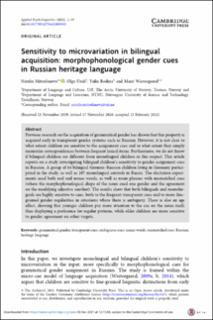| dc.contributor.author | Mitrofanova, Natalia | |
| dc.contributor.author | Urek, Olga | |
| dc.contributor.author | Rodina, Yulia | |
| dc.contributor.author | Westergaard, Marit | |
| dc.date.accessioned | 2022-02-22T07:53:15Z | |
| dc.date.available | 2022-02-22T07:53:15Z | |
| dc.date.created | 2021-09-14T23:01:01Z | |
| dc.date.issued | 2021 | |
| dc.identifier.citation | Applied Psycholinguistics. 2021, 43 (1), 1-39. | en_US |
| dc.identifier.issn | 0142-7164 | |
| dc.identifier.uri | https://hdl.handle.net/11250/2980672 | |
| dc.description.abstract | Previous research on the acquisition of grammatical gender has shown that this property is acquired early in transparent gender systems such as Russian. However, it is not clear to what extent children are sensitive to the assignment cues and to what extent they simply memorize correspondences between frequent lexical items. Furthermore, we do not know if bilingual children are different from monolingual children in this respect. This article reports on a study investigating bilingual children’s sensitivity to gender assignment cues in Russian. A group of 64 bilingual German–Russian children living in Germany participated in the study, as well as 107 monolingual controls in Russia. The elicitation experiments used both real and nonce words, as well as noun phrases with mismatched cues (where the morphophonological shape of the noun cued one gender and the agreement on the modifying adjective another). The results show that both bilinguals and monolinguals are highly sensitive to cues, both to the frequent transparent cues and to more fine-grained gender regularities in situations where there is ambiguity. There is also an age effect, showing that younger children pay more attention to the cue on the noun itself, thus displaying a preference for regular patterns, while older children are more sensitive to gender agreement on other targets. | en_US |
| dc.language.iso | eng | en_US |
| dc.publisher | Cambridge University Press | en_US |
| dc.rights | Navngivelse 4.0 Internasjonal | * |
| dc.rights.uri | http://creativecommons.org/licenses/by/4.0/deed.no | * |
| dc.title | Sensitivity to microvariation in bilingual acquisition: Morphophonological gender cues in Russian heritage language | en_US |
| dc.type | Peer reviewed | en_US |
| dc.type | Journal article | en_US |
| dc.description.version | publishedVersion | en_US |
| dc.source.pagenumber | 1-39 | en_US |
| dc.source.volume | 43 | en_US |
| dc.source.journal | Applied Psycholinguistics | en_US |
| dc.source.issue | 1 | en_US |
| dc.identifier.doi | 10.1017/S0142716421000382 | |
| dc.identifier.cristin | 1934354 | |
| dc.relation.project | UiT Norges arktiske universitet: 2062165 | en_US |
| dc.relation.project | Norges forskningsråd: 250857 | en_US |
| dc.relation.project | Senter for grunnforskning: CAS 2019/2020 MultiGender | en_US |
| cristin.ispublished | true | |
| cristin.fulltext | original | |
| cristin.qualitycode | 1 | |

